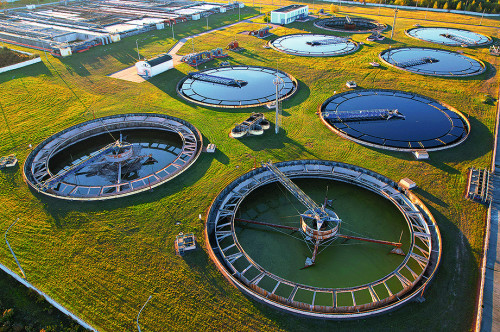Research project investigates bioeconomic value creation.
The Baden-Württemberg Ministry for the Environment, Climate Protection and the Energy Sector is funding the KoalAplan project, which is expanding the functional scope of a wastewater treatment plant to include options for recovering raw materials from wastewater. The project aims to make a positive contribution to climate neutrality, as the products obtained replace fossil raw materials and energy-intensive processes.
Scientists from the DVGW Research Center at the Engler-Bunte Institute of the Karlsruhe Institute of Technology (KIT), the Fraunhofer Institute for Interfacial Engineering and Biotechnology IGB, the Technical University of Hamburg, the University of Stuttgart and the Clausthal University of Technology are working together with Umwelttechnik Baden-Württemberg (UTBW), the state agency for environmental technology and resource efficiency, on a project on new wastewater treatment processes. The KoalAplan project aims both to recover raw materials from wastewater and to make a positive contribution to climate neutrality. The abbreviation KoalAplan stands for "Municipal wastewater as a source of ammonium nitrogen, hydrogen and bioplastics".
Removing nitrogen biologically
In a conventional wastewater treatment plant, the nitrogen contained in the wastewater is broken down biologically. Microorganisms convert the nitrogen compounds into gaseous nitrogen, which escapes unused into the atmosphere. To do this, the microorganisms need organic carbon, which is no longer available as a raw material but is discharged asCO2 andsewage sludge.
"We are bypassing biological nitrogen removal in our project and want to show that we can recover a large part of the organic load from the wastewater," says Prof. Dr. Harald Horn, head of the DVGW research unit at the Engler-Bunte Institute and professor at KIT.
 Wastewater treatment plants are to be coupled with recovery plants in the future (Photo: Adope Stock)
Wastewater treatment plants are to be coupled with recovery plants in the future (Photo: Adope Stock)
The planned process concept consists of chemical, physical and biological process steps. A core element of the entire process is the use of microscreens to separate the particulate organic carbon from the wastewater flow after the preliminary treatment stage. In the main stream process, the ammonium nitrogen is then removed using ion exchangers to produce a product that can be used as a fertilizer. The filtered solids and the primary sludge are first converted into organic acids by acid hydrolysis (dark fermentation) in the side stream process - the actual biorefinery - which also produces biohydrogen andCO2. The hydrolysate is then filtered and converted to hydrogen (and againCO2) using microbial electrolysis. Hydrogen has many applications in the chemical industry and is considered a future energy source.
Testing at the University of Stuttgart's wastewater treatment plant
In a feasibility study, the gas streams from microbial electrolysis and dark fermentation are utilized in a biotechnological process for the production of valuable chemicals, whereby the carbon dioxide contained is also re-fixed.
The material streams, which contain carboxylic acids among other things, are converted into polyhydroxyalkanoates (PHA), a natural biopolymer, in a fermentation process. "We use waste streams to produce the microbial biopolymer PHA, a starting material for biodegradable packaging materials and can thus replace persistent plastics from fossil sources," says Dr. Susanne Zibek, Head of the Bioprocess Technology Group at the Fraunhofer IGB.
The new process concept is being tested at the University of Stuttgart's wastewater treatment plant. Innovative processes for wastewater treatment are being tested at the Büsnau site. There, they have often had to overcome prejudices, but have usually been rewarded with success.
The project is also investigating what other effects the innovations will have. "A detailed life cycle assessment will show whether the process makes a positive contribution to the environment and the climate. With the help of a climate and energy balance, the process can be compared with conventional wastewater treatment plant operation.
The project networks the local players and looks for regional customers for the products generated. All those involved in the project are convinced of the market potential and economic viability of the process.
The KoalAplan project aims to demonstrate the potential for recycling in wastewater treatment. The projected extraction of the products hydrogen, bioplastics and nitrogen/phosphorus fertilizer can significantly reduce the current consumption of resources. At the same time, energy-intensive processes will be replaced and emissions reduced. The project was therefore recognized by the Baden-Württemberg Ministry of the Environment, Climate Protection and the Energy Sector as an important part of the state's "Sustainable Bioeconomy for Baden-Württemberg" strategy.
With this strategy, the state government is supporting the transition to a raw material-efficient and cycle-oriented economy based on renewable and biological resources. This serves to protect natural resources and strengthens Baden-Württemberg as a business location.
INFO
Funding and project coordination
The project is funded by the Baden-Württemberg Ministry for the Environment, Climate Protection and the Energy Sector as part of the ERDF program "Bioeconomy - Biorefineries for the recovery of raw materials from waste and wastewater - Bio-Ab-Cycling". ERDF is a European structural fund that supports economic, territorial and social cohesion within the EU.
Project coordination and public relations are carried out by Umwelttechnik BW, the Baden-Württemberg State Agency for Environmental Technology and Resource Efficiency.
The Fraunhofer IGB is involved in all five biorefinery projects funded by the Ministry of the Environment as part of the ERDF funding program "Bioeconomy Bio-Ab-Cycling". Three of the projects are coordinated under the lead management: InBiRa, SmartBioH2-BW and RoKKa.


